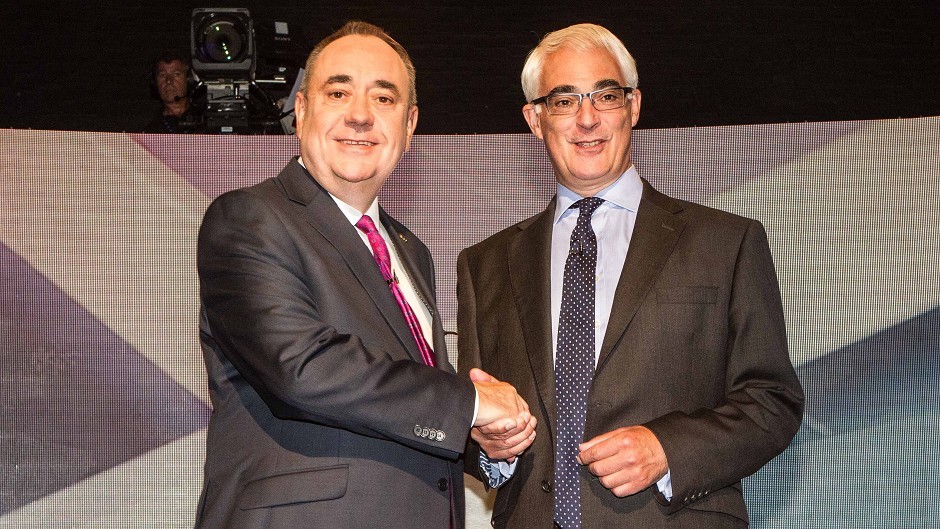Alex Salmond and Alistair Darling went head-to-head for the first time last night in a landmark debate ahead of Scotland’s historic date with destiny.
The SNP first minister and former Labour chancellor passionately set out the case for and against independence in front of about 350 people at the Royal Conservatoire of Scotland in Glasgow.
Mr Salmond, MSP for Aberdeenshire East, claimed voting ‘yes’ was a “vote for ambition over fear” – a decision that “tells the world Scotland carries itself with confidence and self belief”.
“This is our moment – let’s take it,” he added.
But Mr Darling, who served as chancellor in Gordon Brown’s government, said too much of the debate had been “characterised by guess work, blind faith and crossed fingers”.
He stressed that Scotland was already successful “because of the UK, not in spite of it”.
Mr Darling said: “I am optimistic about Scotland’s future within the UK.
“I do not want to see our children’s future gambled away.”
Mr Salmond had hoped to debate the merits of disengaging from the 307 year political union with Prime Minister David Cameron but was forced to settle with facing the Better Together group leader.
The debate in front of an audience of yes, no and undecided voters from all walks of life who live across Scotland was broadcast live on television.
Issues discussed during the lively and often heated debate included currency, tax contributions, EU membership, pensions and high education funding.
Only people who live in Scotland have a vote on September 18, which the SNP says would enable people in this country to take the country’s future in their own hands.
Mr Salmond argues that Scotland is one of the wealthiest countries on earth and independence would enable people to harness its natural resources and skills to build a fairer and more progressive country.
He believes those who live and work in this country were best placed to make all decisions for Scotland and a “yes” vote meant people would always get governments they vote for.
But Mr Darling argues that Scotland currently enjoys the best of both worlds – a parliament in Edinburgh which has control of key areas such as health and education and the safety and security of the UK.
Opinion polls have so far shown a majority in favour of rejecting independence and Mr Salmond will be hoping that his performance last night will give the cause he holds so dear the boost it needs to win the referendum.
Yes campaigners will also be hedging their bets that the feel good factor from the Commonwealth Games, in which Team Scotland finished fourth with 53 medals will also have a positive impact.
But a survey of 1,006 people carried out by Ipsos Mori poll for STV showed that 89% said the sporting event would have no impact on how they vote in the referendum.
The poll showed 40% of those certain to vote in the referendum would vote “yes” and 54% “no” with 7% undecided.
When undecided voters are removed from the figures, 58% of those certain to vote would vote “no” while 42% would vote “yes”.
Mr Salmond, who was wearing a dark suit and a dark pink tie, highlighted that many countries which took part on the Commonwealth Games were smaller than Scotland.
“My case this evening is this – no one, no one will do a better job of running Scotland than the people who live and work in this country,” he added.
“On the 18th of September we have the opportunity of a lifetime.
“We should seize that opportunity with both hands.”
But Mr Darling, who was wearing a dark suit and blue spotted tie, argued independence was not the “best thing to do” and “there is no going back”.
He promised that a vote to say no thanks was not a vote for no change and extra powers for Holyrood, such as more control over income tax, was “guaranteed”.
Mr Darling grilled the first minister on what currency an independent Scotland would use and urged him to reveal what his plan B would be.
But Mr Salmond argued that it was Scotland’s pound too and claimed the position taken by unionist parties was a “campaign tactic” and would change during independence negotiations.
